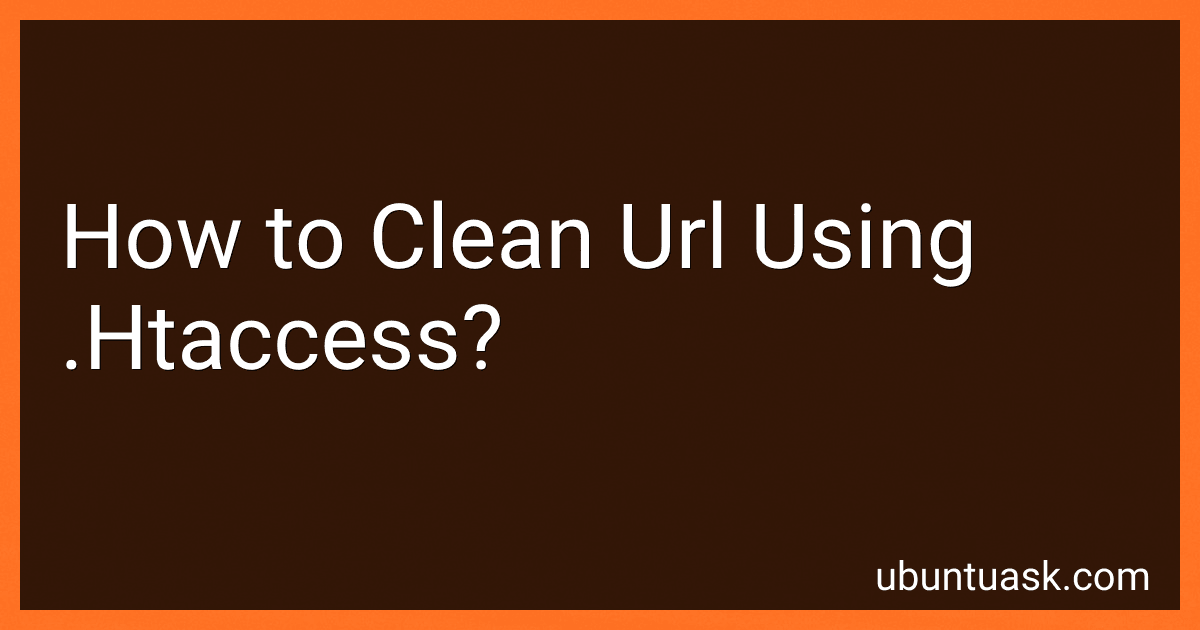Best URL Cleaning Tools to Buy in December 2025
To clean URLs using .htaccess, you can use RewriteRule directives to rewrite URLs in a cleaner format. This is typically done to make URLs more human-readable and search engine-friendly.
For example, you can remove file extensions such as .php or .html from URLs, or you can convert dynamic URLs with query strings into static-looking URLs.
To do this, you need to create rewrite rules in the .htaccess file located in the root directory of your website. These rules use regular expressions to match patterns in the incoming URL and redirect it to the desired clean URL format.
For instance, you can use a rule like this to remove file extensions from URLs: RewriteRule ^(.*).html$ /$1 [R=301,L]
Or you can use a rule like this to convert a dynamic URL into a static one: RewriteRule ^blog/([0-9]+) /blog.php?id=$1 [L]
By using these rules, you can effectively clean up your URLs and improve the overall usability and SEO of your website. Just be sure to test your rules thoroughly to ensure they work as intended without causing any unexpected issues.
What is the AllowOverride directive in .htaccess?
The AllowOverride directive in .htaccess is used to control which directives from the main server configuration can be overridden by directives in the .htaccess file within a directory. It allows the server administrator to restrict the types of directives that can be overridden, providing an additional layer of security and control over the configuration of the server.
How to enable browser caching using .htaccess?
To enable browser caching using .htaccess, you can add the following code to your .htaccess file:
# Enable browser caching <IfModule mod_expires.c> ExpiresActive On ExpiresByType image/jpg "access 1 year" ExpiresByType image/jpeg "access 1 year" ExpiresByType image/gif "access 1 year" ExpiresByType image/png "access 1 year" ExpiresByType text/css "access 1 month" ExpiresByType application/pdf "access 1 month" ExpiresByType text/x-javascript "access 1 month" ExpiresByType application/x-shockwave-flash "access 1 month" ExpiresByType image/x-icon "access 1 year" ExpiresDefault "access 2 days"
This code sets the expiration times for different types of files, such as images, CSS, JavaScript, PDFs, and more. You can customize the expiration times to fit your specific needs. Make sure to check if the mod_expires module is enabled on your server before adding this code.
What is the importance of clean URLs for SEO?
Clean URLs are important for SEO because they make it easier for search engines to crawl and index your website's pages. Clean URLs are typically short, descriptive, and keyword-rich, which can help search engines understand the content of the page and rank it higher in search results.
Additionally, clean URLs are easier for users to read and understand, which can improve the user experience and increase click-through rates. When users can easily read and understand a URL, they are more likely to click on it and visit your website.
In summary, clean URLs improve the visibility of your website in search engine results, enhance the user experience, and can ultimately help drive more organic traffic to your site.
What is the purpose of the RewriteOptions directive in .htaccess?
The RewriteOptions directive in .htaccess is used to configure various options for URL rewriting and redirection in Apache. This directive allows you to specify different behaviors and settings for Apache's mod_rewrite module, such as enabling or disabling certain features, setting default parameters, and controlling how rewrite rules are processed. It allows for fine-tuning of the rewrite engine to achieve specific requirements for URL rewriting in the web server configuration.
